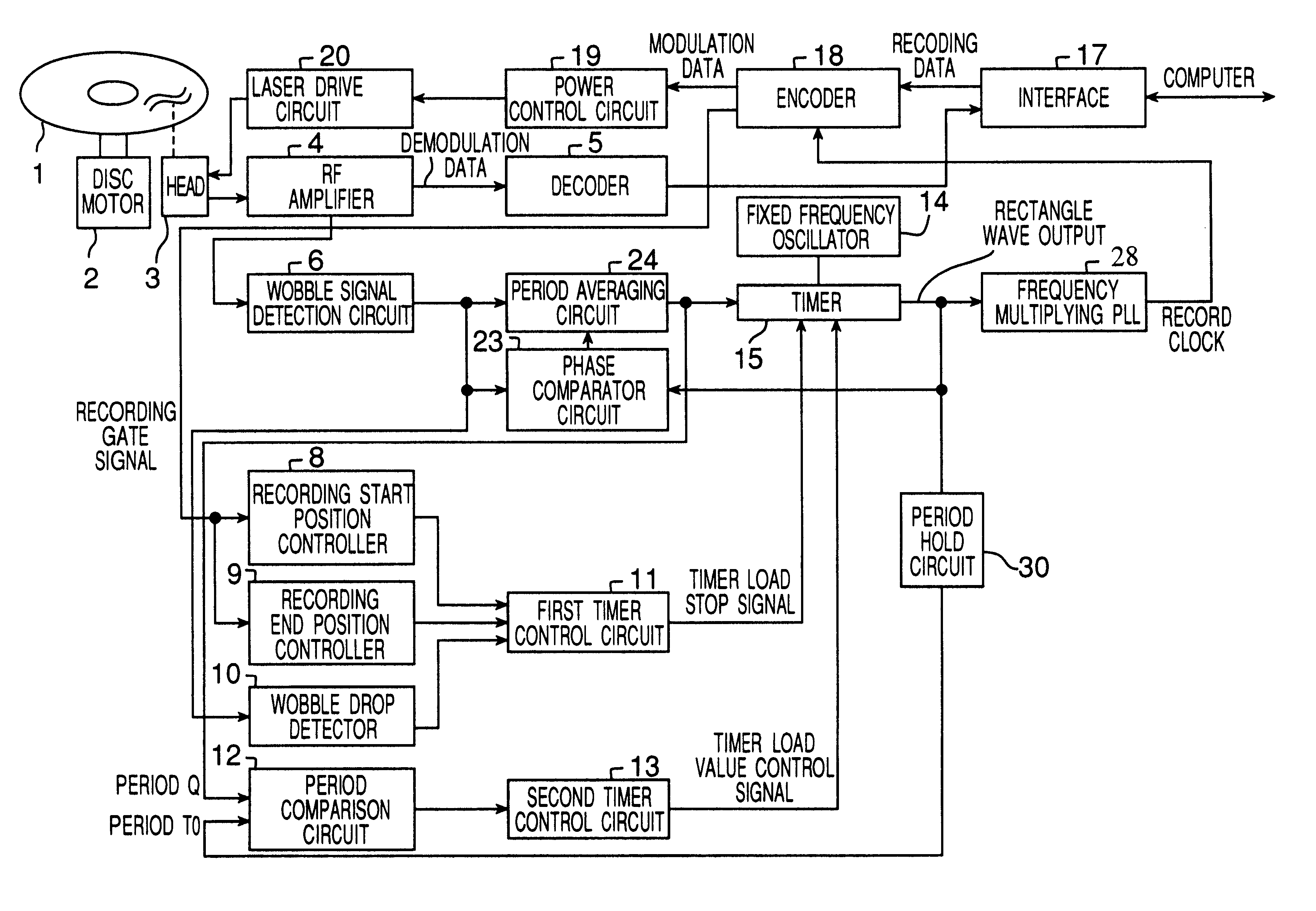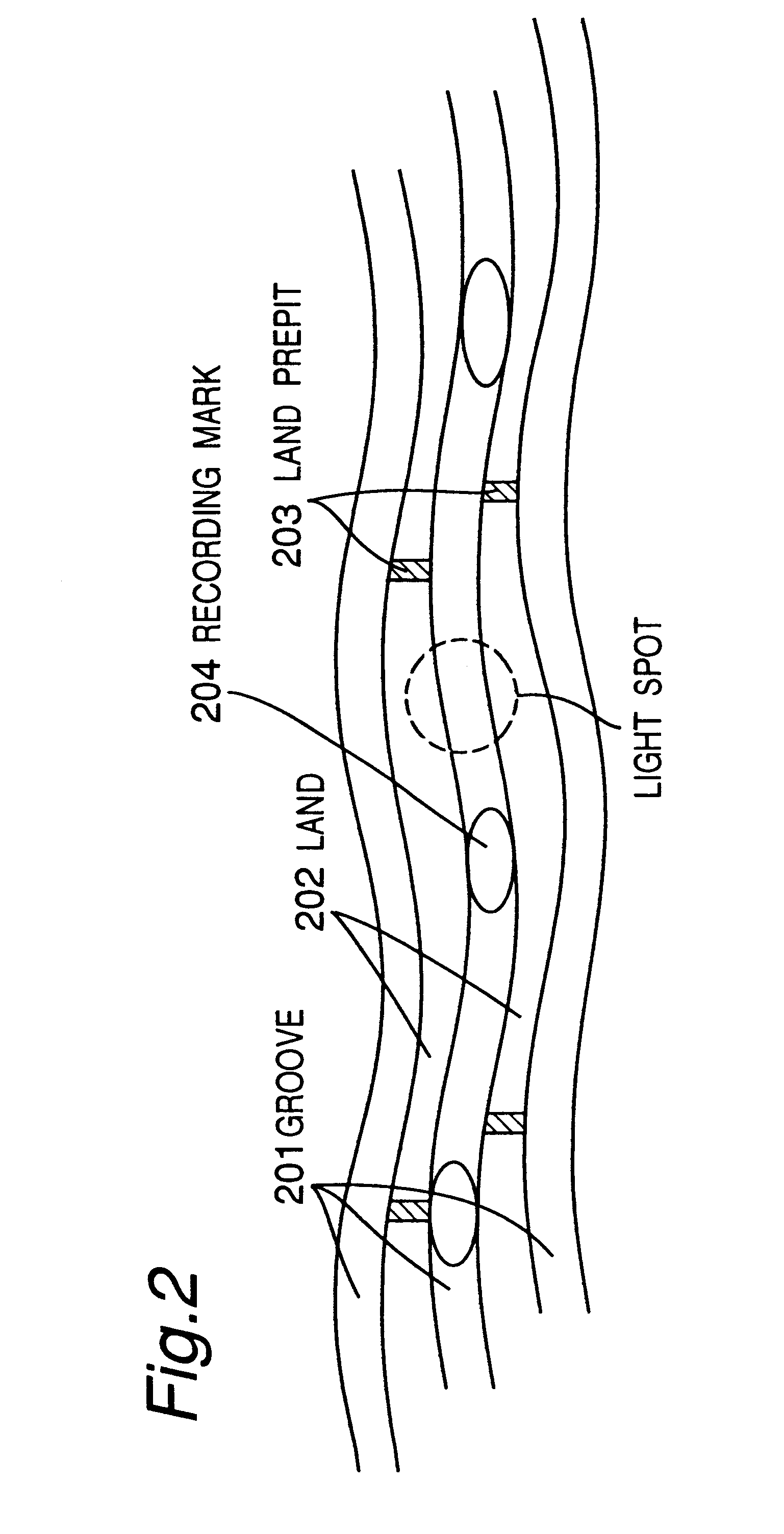Recording clock generating device and method thereof
a recording clock and generating device technology, applied in the direction of recording signal processing, digital signal error detection/correction, instruments, etc., can solve the problems of increasing circuit scale, recording clock jitter, and wiggle phase not matching from track to track
- Summary
- Abstract
- Description
- Claims
- Application Information
AI Technical Summary
Benefits of technology
Problems solved by technology
Method used
Image
Examples
first embodiment
The typical groove configuration of a disk as conceived by the present invention is shown in FIG. 2. Shown in FIG. 2 are a groove 201, land 202, a land prepit 203 that is formed on a land, and a recording mark 204 that is recorded to a groove. The undulations in the recording grooves are called “wobble” and are used to detect the linear velocity of the disk. The land prepits are used to generate the recording clock and for CLV control. In DVD-R and DVD-RW discs, the wobble period is 186 times the recording clock frequency. The land prepits 203 are encoded with address information and are used for detecting a precise location on the disk.
The recording format of the disk is shown in FIG. 3. As shown in FIG. 3, the recording format 301 has 26 frames per sector; one frame has a length of eight wobble periods. A photodetector which is divided into plural photodetection segments in a line that is substantially parallel to the tracking direction detects light that is reflected from the gro...
second embodiment
This second embodiment of the present invention can smoothen the change in the timer output period as compared with the first embodiment, and can be expected to improve jitter in the recording clock which is obtained by multiplying the timer output, by updating the period average every wobble period. In addition, by reflecting the wobble signal and the timer output phase difference in the timer setting, the accumulation of period averaging rounding error and timer resolution error can be suppressed, and the wobble signal and timer output can be kept in phase.
Third Embodiment
FIG. 1 is a block diagram of a third embodiment of the present invention. As shown in FIG. 1 this third embodiment has the optical disk 1, disk motor 2, head 3, RF amplifier 4, decoder 5, wobble signal detection circuit 6, recording start position controller 8, recording end position controller 9, wobble drop detector 10, first timer control circuit 11, period comparison circuit 12, second timer control circuit 1...
third embodiment
This third embodiment of the present invention can easily detect the phase of the wobble signal and the land prepit signal and can correct the phase of the recording clock using the land prepit signal by effectively combining a frequency multiplying PLL with a small scale, digitally configurable period averaging circuit and low-pass filter.
The wobble frequency is 140 kHz, the land prepits appear every two frames (approximately 10 kHz), the PLL response band from tracking disk eccentricity is approximately 1 kHz, and wobble interference between tracks has a relatively slow period of 5.3 revolutions in DVD-R media. The timer phase correction response speed of 140 kHz in the period averaging circuit is therefore sufficient to measure the phase difference between the wobble signal and the land prepits appearing at approximately 10 kHz. Furthermore, by setting the cutoff frequency of the low-pass filter to approximately 1 kHz, it is possible to phase correct the frequency multiplying PLL...
PUM
| Property | Measurement | Unit |
|---|---|---|
| frequency | aaaaa | aaaaa |
| frequency | aaaaa | aaaaa |
| wobble frequency | aaaaa | aaaaa |
Abstract
Description
Claims
Application Information
 Login to View More
Login to View More - R&D
- Intellectual Property
- Life Sciences
- Materials
- Tech Scout
- Unparalleled Data Quality
- Higher Quality Content
- 60% Fewer Hallucinations
Browse by: Latest US Patents, China's latest patents, Technical Efficacy Thesaurus, Application Domain, Technology Topic, Popular Technical Reports.
© 2025 PatSnap. All rights reserved.Legal|Privacy policy|Modern Slavery Act Transparency Statement|Sitemap|About US| Contact US: help@patsnap.com



